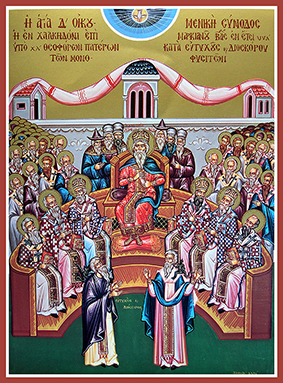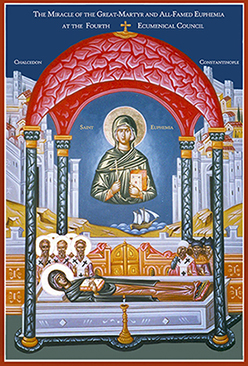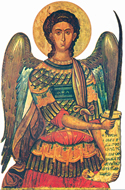 Loading... Please wait...
Loading... Please wait...Search our Talks
MP3 Downloads
Update on New Talks
The Fourth Ecumenical Council
The Fourth Ecumenical Council
Commemorated on the Sunday between 13 and 19 July

What is an Orthodox Council?
The Church held councils to resolve issues when less formal dialogue failed to produce a consensus. Most councils were local, although in some cases their decrees gained wide acceptance (such as the Seven Ecumenical Councils). The first council of the Church was held by the Apostles in Jerusalem during the first century (refer to Acts 6:1-7).
The seven General Councils of the entire Christian Church are known as the Ecumenical Councils. They cover the period between 325-757 AD and their decisions are at the foundation of Christian doctrine accepted by both the Eastern and Western segments of the Christian Church. The decisions of these Ecumenical Councils were made under the guidance of the Holy Spirit, as promised by Jesus Christ to His Apostles. At these Ecumenical Councils many Canons, or laws governing the administration of the Church, were composed.
The Fourth Ecumenical Council
The Fourth Ecumenical Council was convened at Chalcedon, on the Asian side of Constantinople, by Emperor Marcian and his wife Poulcheria in 451. It had to deal with another controversy about the Person of Christ. Eutyches, an Archimandrite in Constantinople, held that the human (less perfect) nature of Christ had been completely absorbed by His divine nature and thus the two had been confounded into one. Thus, after this union, Eutyches held, there was only one nature in Christ. Hence his heresy was called ‘monophysitisim’ (of one nature). The Council condemned this teaching and affirmed that there were two perfect natures in the one Person of Christ unified ‘unconfusedly, unchangeably, indivisibly, and inseparably’.
The Council was attended by 650 bishops. The dogmatic decisions of this Council were expressed by a statement of faith since then called the Chalcedonian Definition.
Adapted from an essay by the Late Very Rev N Patrinacos
The Miracle of Saint Euphemia the All-praised
at the Fourth Ecumenical Council
Commemorated 11 July

The holy Great Martyr Euphemia (September 16) suffered martyrdom in the city of Chalcedon in the year 304, during the time of the persecution against Christians by the emperor Diocletian (284-305). One and a half centuries later, at a time when the Christian Church had become victorious within the Roman Empire, God deigned that Euphemia the All-Praised should again be a witness and confessor of the purity of the Orthodox teaching.
In the year 451 in the city of Chalcedon, in the very church where the glorified relics of the holy Great Martyr Euphemia rested, the sessions of the Fourth Ecumenical Council (July 16) took place. The Council was convened for determining the precise dogmatic formulae of the Orthodox Church concerning the nature of the God-Man Jesus Christ. This was necessary because of the widespread heresy of the Monophysites ["mono-physis" meaning "one nature"], who opposed the Orthodox teaching of the two natures in Jesus Christ, the Divine and the Human natures (in one Divine Person). The Monophysites falsely affirmed that in Christ was only one nature, the Divine [i.e. that Jesus is God but not man, by nature], causing discord and unrest within the Church. At the Council were present 630 representatives from all the local Christian Churches. On the Orthodox side Anatolius, Patriarch of Constantinople (July 3), Juvenal, Patriarch of Jerusalem (July 2), and representatives of St Leo, Pope of Rome (February 18) participated in the conciliar deliberations. The Monophysites were present in large numbers, headed by Dioscorus, the Patriarch of Alexandria, and the Constantinople archimandrite Eutychius.
After prolonged discussions the two sides could not come to a decisive agreement.
The holy Patriarch Anatolius of Constantinople proposed that the Council submit the decision of the Church dispute to the Holy Spirit, through His undoubted bearer St Euphemia the All-Praised, whose wonderworking relics had been discovered during the Council’s discussions. The Orthodox hierarchs and their opponents wrote down their confessions of faith on separate scrolls and sealed them with their seals. They opened the tomb of the holy Great Martyr Euphemia and placed both scrolls upon her relics. Then, in the presence of the emperor Marcian (450-457), the participants of the Council sealed the tomb, putting on it the imperial seal and setting a guard to watch over it for three days. During these days both sides imposed upon themselves strict fast and made intense prayer. After three days the patriarch and the emperor in the presence of the Council opened the tomb with its relics: the scroll with the Orthodox confession was held by St Euphemia in her right hand, and the scroll of the heretics lay at her feet. St Euphemia, as though alive, raised her hand and gave the scroll to the patriarch. After this miracle many of the hesitant accepted the Orthodox confession, while those remaining obstinant in the heresy were consigned to the Council’s condemnation and excommunication.
After an invasion by the Persians during the seventh century, the relics of St Euphemia were transferred from Chalcedon to Constantinople, into a newly built church dedicated to her. Many years later, during the period of the Iconoclast heresy, the reliquary with the relics of the saint was cast into the sea by order of the Iconoclast emperor Leo the Isaurian (716-741). The reliquary was rescued from the sea by the ship-owning brothers Sergius and Sergonos, who gave it over to the local bishop. The holy bishop ordered that the relics be preserved in secret, beneath a crypt, since the Iconoclast heresy was continuing to rage. A small church was built over the relics, and over the reliquary was put a board with an inscription stating whose relics rested within. When the Iconoclast heresy was finally condemned at the holy Seventh Ecumenical Council (in the year 787), during the time of St Tarasius, Patriarch of Constantinople (784-806) and the emperor Constantine VI (780-797) and his mother St Irene (797-802), the relics of the holy Great Martyr Euphemia were once again solemnly transferred to Constantinople.
The Monastery of Panagia Ypseni, Rhodes
Source: Orthodox Christianity Website



